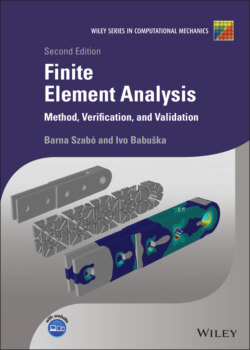Читать книгу Finite Element Analysis - Barna Szabó - Страница 45
Examples
ОглавлениеThe properties of the finite element solution with reference to a family of model problems is discussed in the following. The problems are stated as follows: Find such that
where κ and c are constants and is defined such that the exact solution is:
As explained in Section 1.5.1, when α is not an integer, the case considered in the following, then this solution lies in the space . Therefore the asymptotic rate of h‐convergence on uniform meshes, predicted by eq. (1.92), is and the asymptotic rate of p‐convergence on a fixed mesh is .
We selected this problem because it is representative of the singular part of the exact solutions of two‐and three‐dimensional elliptic boundary value problems.
Referring to Theorem 1.3, we have for all therefore . Consequently for the kth element the load vector in the local numbering convention is:
where by definition .
When then the first derivative of is infinity in the point . To avoid having in the integrand, the first term in eq. (1.105) is integrated by parts:
Since for and , we have:
and for we have:
where is the Legendre polynomial of degree and eq. (D.10) was used.
Since the exact solution is known, the exact value of the potential energy can be determined for any set of values of α, κ, c and . When κ and c are both constants then
(1.107)
The exact values of the potential energy for the data , and and various values of α are shown in Table 1.2.
Table 1.2 Exact values of the potential energy for , and .
| α | α | ||
|---|---|---|---|
| 0.600 | −2.3728354978 | 1.000 | −1.0000000000 |
| 0.700 | −1.7571858289 | 1.500 | −0.5104166667 |
| 0.800 | −1.4176885916 | 2.000 | −0.3047619048 |
| 0.900 | −1.1799028822 | 3.000 | −0.1420634921 |
When α is a fractional number then derivatives higher than α will not be finite in . In the range the first derivative in the point is infinity. This range of α has considerable practical importance because the exact solutions of two‐ and three‐dimensional problems often have analogous terms.
When α is an integer then all derivatives of are finite. Therefore can be approximated by Taylor series about any point of the domain . It is known that the error term of a Taylor series truncated at polynomial degree p is bounded by the th derivative of :
(1.108)
In the special case when α is an integer and then .
Exercise 1.19 Show how eq. (1.106) is obtained from eq. (1.105). Provide details.
Example 1.10 Let us consider model problems in the form of eq. (1.103) with the following data: , , and exact solutions in the form of eq. (1.104) corresponding to . We will use a sequence of uniform finite element meshes with and assigned to all elements. We are interested in the relationship between the estimated and true relative errors. The computed values of the potential energy and their estimated limit values computed by means of eq. (1.99) are listed in Table 1.3. These are comparable to the exact values of the potential energy listed in Table 1.2. The estimated limit values of the potential energy are denoted by .
With the information provided in Tables 1.2 and 1.3 it is possible to compare the estimated and exact values of the relative error. For example, using eq. (1.100) and
Table 1.3 Example: Computed and estimated values of the potential energy . Uniform mesh refinement, for all elements.
| N | |||||
|---|---|---|---|---|---|
| 10 | 19 | −2.17753673 | −1.73038992 | −1.41382648 | −1.17955239 |
| 100 | 199 | −2.25079984 | −1.74673700 | −1.41675042 | −1.17984996 |
| 1000 | 1999 | −2.29589857 | −1.75303348 | −1.41745363 | −1.17989453 |
| −2.37254083 | −1.75716094 | −1.41768637 | −1.17990276 |
the estimated relative error in energy norm for , is:
or 5.22%. When using the exact value of the potential energy for reference then the relative error is the same as the estimated relative error to within three digits of accuracy:
Exercise 1.20 Compare the estimated and exact values of the relative error in energy norm for the problem in Example 1.10 for , .
Example 1.11 Let us consider once again model problems in the form of eq. (1.103) with the data: , , and exact solutions corresponding to , see eq. (1.104). Using a sequence of uniform finite element meshes with and assigned to each element, the results shown in Fig. 1.9 are obtained. The values of β were computed by linear regression using eq. (1.101). We observe that . This is consistent with the asymptotic estimate given by eq. (1.91).
Example 1.12 Let us consider model problems in the form of eq. (1.103) with the data: , , and exact solutions corresponding to , see eq. (1.104). Using a uniform finite element mesh with and assigned to each element, the results shown in Fig. 1.10 are obtained. The values of β were computed by linear regression using eq. (1.101). We observe that , that is, the rate of convergence is twice that in Example 1.11. This is consistent with the theoretical results in [22, 84]: The rate of p‐convergence is at least twice the rate of h‐convergence when the singular point is a nodal point.
